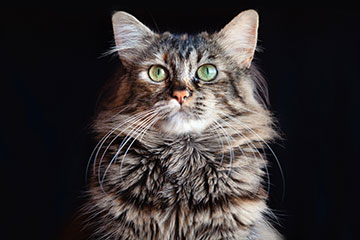
The artificial-vision system has a slit-like elliptical aperture and a patterned metal reflector, based on a cat’s eye structure, to improve object detection and recognition in various lighting conditions. [Image: Cris Cantón/ Getty Images]
Many predatory animals have developed specialized vision for hunting prey. For example, cats’ pupils narrow to vertical slits in bright light for distinguishing food targets from their surroundings. At night, wide circular pupils and a retroreflective internal eye feature increase the cat’s sensitivity to light.
Inspired by these feline adaptations, researchers in the Republic of Korea have designed an artificial-vision system with a slit-like aperture and a metal reflector that boosts photosensitivity (Sci. Adv., doi: 10.1126/sciadv.adp2809). The biomimetic device could help drones and self-driving vehicles identify important objects among background clutter.
Mimicking a cat’s eye
“Most of our research in bioinspired optics builds on the phenomena and analyses discovered by various biologists,” says study author Young Min Song, Gwangju Institute of Science and Technology (GIST). “Previous studies have suggested that small predators, such as cats—referred to as ambush-type predators—can reduce background noise through their vertical pupils. Since our focus is on optics, we delved deeper into how adopting vertical pupils can enhance hunting efficiency.”
Song and his colleagues realized that the narrow circular pupil of the human eye brings both target and background objects into focus under bright light. To a robotic system using artificial vision, though, the clutter of the visual field as seen through a small round aperture could present real problems—perhaps masking the distinction between a pedestrian and stationary buildings.
On the other hand, the asymmetric shape of a vertical-slit pupil produces asymmetrical depths of field in the tangential and sagittal planes of viewing and enhances the contrast between a desired object and its background in bright light.
Cats also have a retroreflective layer, the tapetum lucidum, directly behind the retinas of their eyes. This layer produces the unusual glow sometimes captured in flash photographs of pets. But the tapetum lucidum plays a practical role in dusk or night hunting: The light reflecting back from the eye helps the cat see its prey.
From eyes to camera
By building hardware that mimics the cat’s eye structure, the team learned how to selectively filter out desired information even in highly noisy environments, which results in better identification of hidden objects.
The GIST artificial-vision system consists of an optical lens with switchable apertures (elliptical, small round and large round) and a hemispherical array of silicon photodetectors backed by a patterned silver reflector. Although reflectors are not usually placed behind sensors, Song says, retroreflectors that act like the tapetum lucidum are commonly incorporated in road signs.
Many other researchers have tackled the artificial-vision problem with artificial intelligence, such as deep learning-based image classification. “However, the more precisely we attempt to extract desired information, the higher the computational load becomes,” Song says.
By building hardware that mimics the cat’s eye structure, the team learned how to selectively filter out desired information even in highly noisy environments, which results in better identification of hidden objects. During their experiments involving a standardized image data set in a noisy network, a camera using a conventional convolutional neural network yielded an accuracy of 88.89%. “However, with the cat’s eye structure, the accuracy significantly improved to 94.44%,” Song says.
The researchers hope their proof-of-concept camera will someday boost reconnaissance and self-driving scenarios. However, Song says, the aperture must be able to change dynamically. “To mimic a cat’s eye, where the aperture adjusts based on incoming light, a different technological approach will be necessary—possibly involving tunable photonics,” he adds. “On the image-processing side, a deeper analysis of the processes occurring in the cat's visual cortex and the implementation of neuromorphic devices that replicate these functions could enable a more complete realization of cat’s eye vision.”
